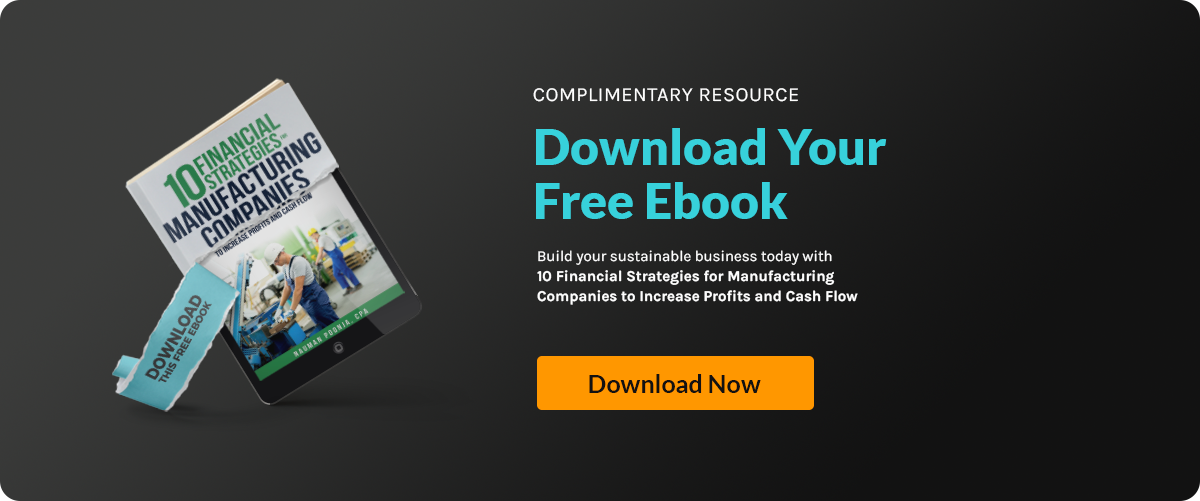Do you understand the difference between a controller and a bookkeeper in manufacturing? Their...
Understanding and Assessing Manufacturing Capital Efficiency Ratios

Have you ever wondered how top-performing companies achieve such high investment returns? A study by Bain & Company found that top-quartile companies often achieve a Return on Invested Capital (ROIC) of 20% or more. Their secret? It's all about understanding and optimizing capital efficiency ratios, a knowledge that can significantly boost your company's financial performance.
Capital efficiency ratios are potent tools that reveal how well your business uses its assets to generate profits. These ratios can pinpoint areas where you can enhance efficiency, cut costs, and boost your bottom line.
Are you curious to see how you stack up? Continue reading to discover how these insights can lead to significant improvements, better resource allocation, and, ultimately, higher profitability.
How Capital Efficiency Attracts Investors
Savvy investors are always on the lookout for companies that make the most of their resources. Demonstrating strong capital efficiency signals to potential backers that your business knows how to turn investment dollars into real results, not just flashy numbers.
Think of it this way: generating $1 million in revenue by maintaining a lean operation is far more impressive than doing so while burning through a mountain of cash. It tells investors your team isn’t just focused on growth, but growth that lasts. They’ll see that departments like finance, sales, and marketing are in sync—carefully evaluating what works, cutting out what doesn’t, and ensuring every dollar is well spent.
When your capital efficiency ratios reflect responsible management and strategic allocation, you don’t just build confidence inside your company—you build a compelling case for investors who want to see their money used wisely and profitably.
Understanding Manufacturing Efficiency and Productivity
Manufacturing efficiency refers to the ability to produce goods while minimizing costs related to time, materials, and energy. It’s all about doing more with less, ensuring each component of the production process is streamlined and cost-effective.
It's important not to confuse manufacturing efficiency with productivity, though they are related. While both aim to enhance production, they approach it differently:
- Efficiency is about quality and effectiveness. It involves optimizing processes to cut waste, reduce errors, and ensure that resources are used judiciously.
- Productivity, on the other hand, focuses on quantity. It's concerned with increasing the volume of goods manufactured, regardless of resource usage or waste generation.
How Capital Efficiency Sustains Growth in Early-Stage Companies
Capital efficiency plays a pivotal role in sustaining growth, especially for early-stage companies aiming to make the most out of every dollar. By closely monitoring capital efficiency, leadership teams can prioritize investments, allocating funds where they have the highest return—rather than spending indiscriminately in hopes of rapid expansion.
For instance, in the early stages, resources might be best spent refining the core product and supporting internal development. There’s no need to ramp up hiring across every department—like sales or marketing—until there’s a strong, market-ready offering. This approach prevents cash burn and ensures that capital is supporting the most crucial phases of growth at the right pace.
Efficient capital use empowers startups to build a foundation for measured, sustainable progress instead of chasing “growth at any cost.” Ultimately, it supports sound decision-making, helps avoid resource waste, and enables companies to weather market fluctuations—setting the stage for long-term success.
How Capital Efficiency Extends Your Financial Runway
Capital efficiency plays a vital role in stretching your company’s financial resources, particularly during periods of economic uncertainty or unpredictable market conditions. When you manage your assets wisely—by investing in initiatives that yield strong returns, carefully controlling expenses, and making data-driven decisions—you give your business a greater cushion to weather slow sales cycles or unexpected downturns.
For example, efficient companies avoid costly pitfalls such as over-hiring or pouring money into oversized marketing campaigns without clear ROI. Instead, they focus on maximizing the impact of every dollar spent, ensuring that their cash reserves last longer and can support sustained operations. Ultimately, capital efficiency helps you sidestep unnecessary financial strain, reduce the risk of disruptive layoffs, and maintain growth momentum—no matter what the market throws your way.
Practical Example
Imagine a factory that churns out 200 widgets daily. If 20% of these widgets fail to meet quality standards, there’s a clear efficiency issue. The focus should be on refining the production process to lower the number of defective units rather than simply trying to produce more widgets.
Key Differences at a Glance:
- Efficiency Goals: Minimize waste, reduce energy consumption, and enhance quality.
- Productivity Goals: Boost output and maximize the use of workforce and machinery.
By focusing on efficiency, businesses can often achieve a more sustainable edge, balancing speed with superior product quality and resource management.
Implementing Capital Efficiency Measures
Manufacturing companies that need to pay more attention to capital efficiency measures often face significant challenges that hinder their growth and profitability. Without these measures, businesses struggle with misallocated resources, excessive costs, and inefficiencies that can harm their financial health. To avoid these issues, here are the steps to effectively implement capital efficiency measures:
Step 1: Assess Current Financial Health
Start your journey toward improved capital efficiency by assessing your company's current financial health. Calculate key financial ratios, such as the inventory turnover ratio, which measures how efficiently a company uses its inventory. This step is crucial as it provides the necessary insights into areas where improvements are needed.
Step 2: Identify Areas for Improvement
Use financial metrics to identify areas where the company can enhance efficiency. Look at metrics like return on investment (ROI) and revenue per employee to understand how well the company utilizes its assets. This helps pinpoint specific areas for improvement.
Step 3: Streamline the Production Process
Review and optimize the production process to reduce total manufacturing costs. This involves analyzing each step of the production process to identify and eliminate inefficiencies. Improving the production process can significantly reduce costs and increase operational efficiency.
Step 4: Optimize Inventory Management
Improve inventory management by regularly calculating the inventory turnover ratio. This ratio measures how effectively the company is converting inventory into sales. Better inventory management helps reduce holding costs and improve cash flow.
Step 5: Enhance Cash Flow Management
Implement measures to enhance cash flow management. This includes monitoring cash inflows and outflows and ensuring the company can meet its short-term obligations. Effective cash flow management is crucial for maintaining financial stability.
Step 6: Benchmark Against Industry Standards
One of the most effective ways to gauge your company’s performance is by benchmarking it against industry standards. This involves comparing your financial ratios and metrics to those of similar companies. Benchmarking is a powerful tool that can help you identify areas where your company is performing well and areas that need improvement.
Step 7: Regularly Review and Adjust
Review the implemented measures regularly and adjust as necessary. Use ongoing financial analysis to ensure the measures effectively improve capital efficiency. Continuous monitoring and adjustment are key to maintaining optimal performance and your confidence in the process.
Common Challenges in Monitoring Capital Efficiency
Tracking and assessing capital efficiency isn’t always straightforward. For many manufacturing companies, a major roadblock is the fragmented nature of financial data. Key metrics like the cash conversion score or asset turnover ratio often reside in different spreadsheets, systems, or departments, making it a time-consuming process to gather and reconcile the relevant information.
Additionally, manual data collection increases the risk of errors and delays, meaning that by the time insights are compiled, they may already be outdated. This can leave decision-makers in a reactive position, frequently addressing issues after they arise rather than anticipating and solving them proactively. Over time, this lag in insights can hamper agile decision-making and make it more challenging to implement timely improvements to maintain efficient operations.
Allocation Analysis for Capital Purchases
Allocation analysis for capital purchases assesses how efficiently a company utilizes its capital. This process involves evaluating the internal rate of return (IRR) and the asset turnover ratio, which measures how efficiently the company uses its assets to generate revenue. By dividing the net income by the cost of goods sold, companies can understand their profitability within a specific period. Practical allocation analysis helps supply chain management by identifying areas of performance that need improvement, ensuring the company’s capital structure is optimized for maximum returns.
Understanding Burn Multiple & Capital Efficiency in SaaS
One of the best ways to measure how wisely your company uses cash—especially in tough markets—is by tracking your burn multiple. This metric shows how much cash you burn to generate each dollar of revenue. It’s calculated by dividing the net cash burned over a set period by the revenue earned in that same period.
For example, if you burn $1 million in a quarter and earn $500,000 in revenue, your burn multiple is 2.0. A lower burn multiple means you’re generating revenue more efficiently.
Why is this important? Unlike metrics that only focus on sales or marketing, burn multiple gives you a big-picture view of overall operational efficiency. Monitoring it regularly—monthly, quarterly, or annually—helps you identify waste, extend your runway, and adjust strategy before problems escalate.
In the SaaS world, capital efficiency is more than a financial buzzword—it’s a make-or-break factor for sustainable growth. When done right, it:
-
Supports smart growth by funding the right priorities—like product development—at the right time.
-
Builds investor confidence by showing that every dollar spent is tied to scalable revenue.
-
Extends your runway so you can survive slow periods or market downturns without drastic cuts.
Bottom line: keeping a close eye on your burn multiple and overall capital efficiency doesn’t just improve your numbers—it sets you up for long-term success in both good times and challenging markets.
What Is the Ideal Capital Efficiency Ratio?
The ideal capital efficiency ratio isn’t a one-size-fits-all figure—it’s shaped by your industry’s unique landscape and operating models. While many consider a 1:1 ratio (one dollar of output for every dollar invested) to be a reasonable benchmark, leaders in capital efficiency often achieve ratios closer to 3:1. In other words, for every dollar invested, these businesses generate three dollars in return.
However, your target ratio should reflect industry norms and your company’s specific circumstances. For example, tech firms and consumer goods companies often have higher capital efficiency ratios compared to capital-intensive industries like manufacturing or utilities. That’s why it’s important to review industry reports from organizations like McKinsey or PWC to set realistic benchmarks. Ultimately, optimizing capital efficiency means evaluating all aspects of your financial health—from cost structure and asset utilization to ROI—so you can make informed decisions that drive sustainable growth.
Key Efficiency Metrics to Evaluate
Understanding key efficiency metrics is essential for manufacturing businesses to assess and enhance performance. These metrics provide valuable insights into how effectively a company uses its resources to generate profits and improve operations.
When evaluating capital efficiency, context is everything. A metric that looks strong for a mature, stable enterprise might not mean the same thing for a rapidly scaling start-up or a business navigating a volatile marketplace. The key is to interpret these numbers in light of your company’s growth stage and prevailing industry conditions.
For early-stage companies, capital is often allocated toward foundational investments like research, product development, or key hires. At this point, efficiency may not always translate into immediate profitability, but rather strategic spending that lays the groundwork for sustainable growth. In contrast, more established companies need to demonstrate disciplined use of capital, ensuring every dollar spent delivers tangible returns.
Market conditions add another layer of complexity. During times of economic uncertainty, prudent cash management and efficient allocation become especially critical. Companies that stretch their resources and avoid reckless spending are more likely to maintain financial stability—even if revenues fluctuate. Ineffective capital deployment, such as premature scaling of sales teams or excessive marketing during a sales slump, can lead to future cutbacks and harm overall growth momentum.
Ultimately, there is no universal benchmark for capital efficiency across all businesses. What matters most is how well your efficiency metrics align with your specific growth phase, the competitive landscape, and your strategic objectives. By tailoring your analysis in this way, you create a more accurate picture of your operational health and long-term potential.
Here are some essential efficiency metrics to consider:
Key Metric #1 - Return on Capital Employed (ROCE)
This metric evaluates a company's effectiveness in generating profits from its total capital employed by dividing earnings before interest and taxes (EBIT) by total capital employed. For accurate results, it's important to consider the company's debt and equity structure, the consistency of EBIT over time, and all current liabilities.
Key Metric #2 - Asset Turnover Ratio
This ratio measures how efficiently a company uses its total assets to generate sales by dividing net sales by total assets. For a comprehensive evaluation, it's crucial to include all assets, consider seasonal variations in sales, and compare the ratio against industry benchmarks.
Key Metric #3 - Inventory Turnover Ratio
This metric assesses how quickly a company sells and replaces its inventory over a specific period by dividing the cost of goods sold by the average inventory. The accuracy of inventory records, the impact of production cycles on inventory levels, and comparison with industry standards are important factors to consider.
Key Metric #4 - Return on Assets (ROA)
ROA measures how effectively a company uses its assets to generate net profit by dividing net profit by total assets. It's essential to ensure all assets, including intangible ones, are included in the calculation, compare the ratio across different periods, and evaluate against industry averages.
To get the most meaningful insights from ROA, it's important to benchmark the ratio not just once, but across multiple time periods. This helps track trends in operational efficiency and highlights areas where asset utilization may be improving or declining. Consider implementing a tiered evaluation—think “Good, Better, Best”—to contextualize your ROA performance in relation to both your company’s historical data and the broader market. This approach helps you understand not only your current efficiency level but also how sustainable your asset-driven profits might be if market conditions change or new investments are made.
Consistent, period-over-period analysis of ROA provides a comprehensive view of how effectively your resources are being put to work, making it a vital metric for ongoing financial health and strategic planning.
Key Metric #5 - Fixed Asset Turnover Ratio
This ratio measures how well a company uses its fixed assets to generate sales by dividing net sales by net fixed assets. It's essential to include only net fixed assets after depreciation, consider the age and condition of fixed assets, and regularly update the asset register for accurate calculations.
How Lack of Manufacturing Efficiency Gives Competitors an Advantage
When your manufacturing processes aren't streamlined, it can lead to a cascade of inefficiencies. Inefficient use of resources, labor, and machinery can hinder your production capabilities. This not only slows down output but can also increase costs.
Meanwhile, competitors who have optimized their operations gain a crucial edge. They can produce goods faster, maintain quality, and offer competitive pricing. Consequently, this can lead to them capturing more market share, leaving your business trailing behind.
Here’s how:
- Cost Efficiency: Competitors with streamlined operations minimize waste and reduce production expenses.
- Speed to Market: Faster production cycles mean they can respond more promptly to market demands.
- Quality Consistency: Efficient processes often lead to fewer defects and higher-quality products.
Thus, if you don’t optimize your manufacturing efficiency, you risk giving your competitors a significant competitive advantage.
Optimization Strategies for Improved Efficiency
Improving manufacturing efficiency is crucial for reducing production costs. By implementing effective optimization strategies, companies can better utilize their resources and streamline operations.
These optimization strategies focus on various aspects of the manufacturing process, from asset management to cost reduction. Here are some practical ways to improve efficiency in your manufacturing business:
- Implement lean manufacturing techniques to minimize waste and improve workflow.
- Use automation and technology to streamline production processes and reduce manual errors.
- Regularly maintain equipment to prevent breakdowns and ensure optimal performance.
- Optimize inventory management to reduce excess stock and improve cash flow.
- Conduct regular performance reviews to identify areas for improvement and implement necessary changes.
- Train employees continuously to enhance their skills and productivity.
- Analyze production data to understand inefficiencies better and address them promptly.
- Implement energy-saving practices to reduce utility costs and improve sustainability.
Boost Profits with Manufacturing Capital Efficiency Ratios with Accounovation
The manufacturing industry relies heavily on optimizing resources and improving efficiency to maintain competitiveness. At Accounovation, our simplified financial reports present clear, practical insights. Our approach helps manufacturing leaders understand their financial data, making it easier to uncover hidden growth opportunities and boost profitability.
Visit the Accounovation website today to schedule a consultation and transform your financial strategy!







